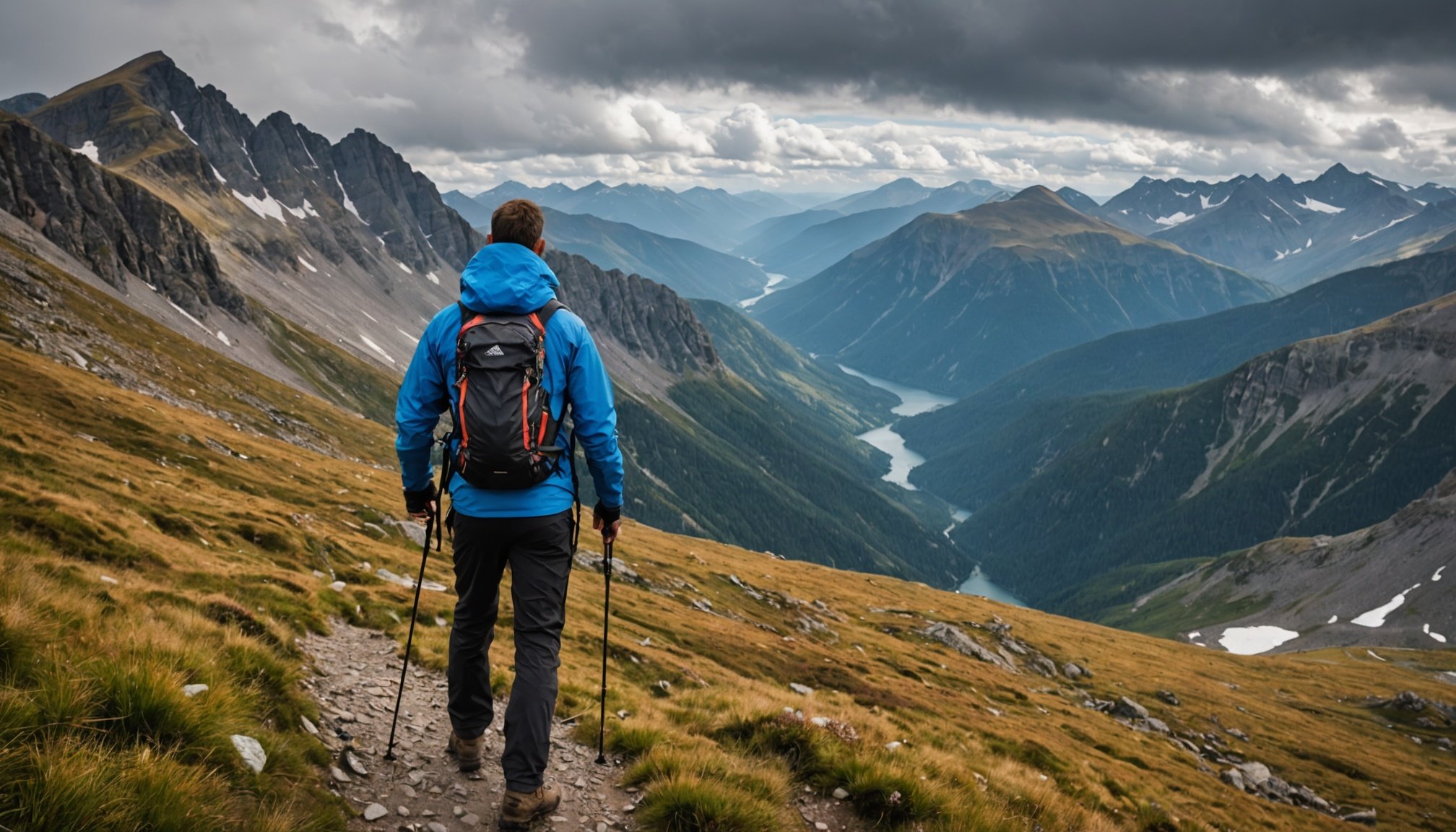Overview of Essential Outdoor Gear for Mountain Hiking
Selecting the right outdoor gear is critical for a safe and comfortable mountain hiking experience. Essential gear needs to meet the demands of changing environments and protect against potential hazards while enhancing overall enjoyment.
When categorising essential gear, start with clothing. Layering is vital. Choose moisture-wicking base layers, insulating mid-layers, and waterproof outer layers. This combination ensures adaptability to fluctuating weather conditions.
Also read : Mastering Oversized Blazer Alterations: Preserve Its Charm While Tailoring to Fit
Next, consider footwear. Robust hiking boots that offer ankle support and have a durable, grippy sole are necessary for challenging terrains. Proper fit reduces the risk of blisters and injuries.
Accessories provide additional assurance against weather unpredictability. A sturdy backpack allows you to carry essentials like hydration systems and snacks. Trekking poles offer extra stability on steep and uneven trails.
In the same genre : Mastering Handbag Harmony: Selecting the Perfect Shape and Style to Complement Every Outfit
Equipping oneself with adaptable gear for varying weather conditions is invaluable. During colder months, thermal layers and insulated footwear retain heat. Conversely, in warmer conditions, lightweight, breathable fabrics prevent overheating.
In summary, assembling the appropriate outdoor gear for mountain hiking enables a safer and more comfortable journey through nature’s diverse landscapes. By considering clothing, footwear, and accessories, hikers can be prepared to tackle various weather conditions and terrains with confidence.
Clothing Selection for Changing Weather Conditions
Choosing the right hiking clothing is crucial for adapting to varying weather conditions. A well-planned layering system can help hikers stay comfortable by providing flexibility in temperature regulation. This system typically consists of three layers: base, mid, and outer layers.
The base layer is in direct contact with the skin and should primarily be made from moisture-wicking materials. These fabrics, often composed of synthetic fibers or merino wool, actively draw sweat away from the body, keeping you dry and reducing the risks of hypothermia.
The mid-layer serves as the insulating layer, trapping body heat to maintain warmth. Materials like fleece or down are ideal for this layer due to their excellent insulating properties while remaining lightweight.
For the outer layer, selecting a jacket or shell crafted from weather-resistant fabric is essential. This layer should protect hikers from external elements such as wind, rain, or snow without compromising breathability. Look for features like waterproofing, wind resistance, and adjustable ventilation options, which can enhance the garment’s adaptability.
Incorporating the right clothing layers enables hikers to efficiently adjust to fluctuating weather conditions. This system not only increases comfort but also ensures safety during outdoor adventures.
Footwear Considerations
Choosing appropriate hiking footwear is essential for a safe and comfortable outdoor adventure. The type of boots you select should match the terrain you’re exploring. For rocky or uneven paths, sturdy boots with excellent traction are necessary to prevent slipping. In contrast, lighter and more flexible footwear may be suitable for well-worn trails.
When considering whether to opt for waterproof or breathable boots, it’s important to understand the conditions you’ll face. Waterproof boots are ideal for hikes in wet environments or during colder months, as they keep your feet dry by repelling water. However, they might be less breathable, potentially causing discomfort during warmer hikes. On the other hand, breathable boots allow for better moisture evaporation, which can be beneficial in hot weather to prevent overheating and blisters.
The fit and support of your hiking boots cannot be overstated, especially for long treks. Properly fitting boots should offer sufficient room for toe movement and secure heel positioning to avoid blisters. Supportive boots help in reducing foot fatigue and provide stability on varied terrain. Always break in new boots before embarking on longer hikes to ensure they mold to your feet and prevent discomfort during use.
Essential Accessories for Comfort and Safety
When embarking on a hiking adventure, having essential hiking accessories is crucial for both comfort and safety. Among these, hats, gloves, and gaiters play a pivotal role. Hats shield you from the sun’s harsh rays, reducing the risk of heatstroke or sunburn. Meanwhile, gloves provide protection against blisters and cold weather, ensuring your hands remain functional and warm. Gaiters keep debris and water out of your boots, a small yet significant comfort booster on uneven terrain.
Navigation tools are indispensable to safely navigate through unfamiliar trails. Maps, compasses, and GPS devices offer various advantages. While maps and compasses provide a reliable, battery-free method for wayfinding, GPS devices offer precise location tracking with additional features such as trail maps and altitude information. Each has its merits, so it’s wise to carry a combination for maximum safety.
A well-stocked first-aid kit is an unspoken necessity in any hiking journey. Accidents happen, and having bandages, antiseptic wipes, and pain relief medication at hand can dramatically increase your ability to handle injuries. Coupled with emergency supplies like thermal blankets and signal mirrors, these items can prove lifesaving in scenarios where quick assistance is not an option. Prioritizing these hiking accessories guarantees a safer and more enjoyable outdoor experience.
Adapting to Temperature Changes
When hiking in the summer, effective temperature management is essential. Opt for light-colored clothing to reflect sunlight, and wear a hat for shade. Hydration plays a crucial role, so carry sufficient water and take regular breaks. Adjust your hiking strategy by starting earlier in the day when temperatures are cooler, and plan routes with ample shade or water sources.
Cold weather gear becomes vital in colder conditions. Layering is key to managing temperature, starting with a moisture-wicking base layer to keep the skin dry. Mid-layers provide insulation, while an outer layer should be waterproof to protect against wind and rain. Investing in high-quality gloves, socks, and hats minimizes heat loss in extremities, significantly improving comfort and safety.
Recognizing signs of hypothermia and heat exhaustion is critical for maintaining health. Symptoms of hypothermia include shivering, slurred speech, and confusion, while heat exhaustion presents as heavy sweating, a weak pulse, and dizziness. If any signs occur, it’s vital to take immediate action: for heat exhaustion, find a cool place, drink fluids, and rest; for hypothermia, get to a warmer environment and use warm clothing or blankets for heat retention. These strategies ensure a safer hiking experience regardless of the weather.
Dealing with Precipitation
Navigating wet weather can be a challenge without the right rain gear. Ensuring you have the right waterproof gear is essential for keeping dry and maintaining comfort during downpours. Here are a few critical components for weather preparedness when it comes to precipitation.
Essential Waterproof Gear
Investing in quality waterproof jackets is fundamental. Look for features like adjustable hoods and sealed seams for enhanced protection. Pair this with waterproof pants, which should offer breathability to prevent overheating while keeping moisture out. Footwear is another crucial consideration. Waterproof boots or shoes provide the protection needed to keep feet dry, especially when dealing with puddles and unexpected splashes.
Techniques for Keeping Gear Dry
Maintaining the effectiveness of your waterproof gear involves occasional reproofing with specific sprays or washes. It’s also vital to ensure gear is thoroughly dried after exposure to rain. Hang jackets and pants fully extended to promote even drying, avoiding direct heat sources that may damage materials.
Equipment for Maximum Protection
Additional equipment to consider can include heavy-duty gloves covered in waterproof layers and compact, portable ponchos for emergencies. Utilizing rain covers for backpacks and electronics is also beneficial. These covers add an extra layer of protection, ensuring your belongings stay secure even in torrential weather.
Managing Wind Conditions
When planning a hike, considering wind protection is crucial for both comfort and safety. Wind can dramatically affect your experience, especially if you are unprepared for windy conditions. Selecting gear that prioritises wind protection is essential.
Firstly, investing in clothing with windproof layers is a fundamental step. Materials like Gore-Tex or Windstopper offer excellent defense against gusty weather, allowing for a more enjoyable hike. Furthermore, layering with these fabrics helps maintain body heat, thereby increasing gear resilience against unpredictable conditions.
When it comes to accessories, choosing items designed for resistance can make a big difference. Look for hats, gloves, and buffs that shield against strong winds. Additionally, using a wind-resistant backpack cover can assure that your items stay dry and undisturbed during travel.
It’s important not only to equip yourself adequately but also to recognise potential high wind hazards. Markers such as swaying trees, flying debris, or sudden temperature drops can indicate dangerous conditions. Responding promptly by seeking shelter or adjusting your route can prevent mishaps.
By following these strategies, hikers can manage windy conditions effectively, ensuring that their gear remains resilient, and their journey continues undeterred.
Expert Tips for Safety and Comfort
Whether you’re tackling weather uncertainties or embarking on a well-planned journey, hiking demands preparation and awareness. Achieving comfort and safety starts with understanding safe hiking practices.
In unpredictable weather, it’s crucial to adhere to safety guidelines. Ensure you have the right equipment, such as all-weather jackets and sturdy boots with good grip. This prevents accidents on slippery trails and protects against sudden cold snaps. Proper navigation tools, like compasses or GPS devices, are vital to avoid straying off-course.
Preparation involves more than just packing gear. Always plan your hike well in advance. Check trail regulations and respect wildlife. A well-stocked backpack with essentials, such as high-energy snacks and hydration systems, empowers you to handle unexpected situations confidently. Memorise landmarks to maintain orientation, a safety tip often shared in expert advice.
Staying informed on weather forecasts is a cornerstone of hiking safety. Invest time in understanding potential weather shifts for your scheduled day. Weather conditions can extensively influence trail accessibility and personal safety. Real-time updates can be a hiker’s best ally in circumventing adverse encounters. When forecasts warn of rough conditions, consider rescheduling your hike for safety.
Empower your hiking journeys by applying these expert tips, transforming your endeavour into an exhilarating, safe, and enjoyable experience.
Product Reviews and Recommendations
When it comes to selecting outdoor gear, understanding which products and brands stand out is crucial. Our gear reviews highlight top-rated brands such as Patagonia, The North Face, and Columbia. These names are synonymous with quality and innovation, often lauded for their gear reliability in the harshest environments.
Brand comparisons play an essential role in decision-making. For instance, Patagonia is frequently praised for its eco-friendly approach and durable materials. The North Face, on the other hand, is renowned for innovative technology that enhances performance in extreme conditions. Columbia strikes a balance with affordability and quality, making it a solid choice for budget-conscious adventurers.
Analysing performance in varied weather conditions unveils each brand’s recommended products. Patagonia jackets provide superior warmth with eco-friendly insulation, while The North Face excels in waterproof technologies, ensuring dryness during abrupt rainfalls. Columbia’s versatile layering systems are great for adapting to fluctuating temperatures.
Consumer feedback is invaluable. Enthusiasts and experts alike share insights on product longevity and comfort. Many users appreciate the sustainability efforts of Patagonia, whereas The North Face’s technical features garner admiration from mountaineers. Columbia’s accessibility and reliable performance make it a favourite among casual hikers.
Choosing the right gear involves weighing these factors, ensuring your adventures are safe and enjoyable.











